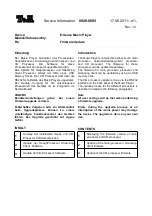
122mkIII Technical Documentation
7733 Telegraph Road • Montebello, CA 90640 • (323) 726-0303 • http://www.tascam.com
All features and specifications are subject to change without notice. Contact your local TASCAM representative for the latest information.
Page 2 of 3
122mkIII_TECHDOC.pdf
032500
The 122mkIII has long been revered as the
standard for cassette mastering, with few
changes made to the original product design.
The original 122 cassette deck was introduced
in 1980. The 122 was TASCAM's first
professional, rack mounted, 3 head cassette
deck with 2 speeds (1 7/8 and 3 3/4). A year
after the product was first introduced, NBC
standardized their entire operation using the
TASCAM 122. The reason NBC made the
change was because the 122 had all the
capabilities for adjustments, and spectacular
performance characteristics. Aided by NBC's
practical endorsement of the TASCAM 122,
ABC and CBS followed, and before long the
122 became the industry standard.
In 1987 the 122MKII continued TASCAM's
leadership in the professional cassette market.
The new features included Dolby HX PRO, the
ability to find locate points, a zero return
function, and pitch control.
The 122mkIII was introduced in 1993
incorporating a new and improved transport
assembly utilizing the Hysteresis Tension
Servo Control System, further improving the
reliability and stability of the legendary 122
heritage.
PRODUCT HISTORY
Not all cassette decks are created equal. While most cassette decks offer
Dolby Noise Reduction of some sort, here are some features you won't
find on most run-of-the-mill cassette decks:
Balanced, Unbalanced, and Front Panel Line Connectors
- Integrate
into any studio, anytime. The rear panel I/O accepts both balanced and
unbalanced signals, and a front panel Line In provides simple patching of
ancillary gear for reference copies, submixes, or spontaneous dubs.
2 Locate Points and Return To Zero
- Locate points can be used for
comparing multiple mixes in quick sequential order, or for marking cues.
Return To Zero is always handy when recording multiple passes.
Dolby HX Pro
- HX Pro algorithms help maintain true printing of high
frequency content. HX Pro recordings do not require any decoding on
playback, so the user can freely apply this system to their recordings.
MPX Filter
- When recording from FM broadcast, Dolby Noise Reduction
can sometimes be compromised by information around the pilot tone at
19kHz, or the sub carrier note at 38kHz. The MPX Filter removes these
troublesome frequencies.
Oscillators, Front Panel Bias & Recording Level Controls
- Each
brand of tape responds to recordings differently. Adjusting the bias
controls on the recorder can help compensate for this. The 122mkIII's
three head design allows for real time monitoring of the test tones as
they are adjusted. For additional convenience, the test tone oscillators
are built right in, so there's no extra test equipment to track down.
Front panel bias and recording level controls make biasing the 122mkIII
effortless. Proper bias settings will result in more reliable sonic
characteristics in most situations.
THE 122mkIII ADVANTAGE
ARCHITECT'S SPECIFICATIONS
The cassette player/recorder shall utilize a three head
cassette mechanism, using separate heads for erase,
record, and reproduce. The transport shall be a direct
drive mechanism and employ the Hysteresis Tension
Servo Control System for increased stability.
Inputs and outputs shall be provided on unbalanced RCA
and balanced XLR plugs on the rear panel. An additional
pair of 1/4" inputs shall be located on the front panel.
Levels shall be displayed on large VU meters with peak
LEDs for accurate display of levels. The input level shall
be controlled by large gear/clutched controls on the front
panel. Stereo output level shall also be provided on the
front panel for convenience. Headphone output with
level control shall be provided on the front panel.
Monitor selection switch shall be provided on the front
panel for selection between input monitor mode and
automatic monitor mode. Dolby™ B and C noise reduction
shall be implemented and switched from the front panel.
An MPX filter shall be switchable from the front panel.
A pitch control will provide approximately ±12% range
of pitch control, with a dedicated on/off control.
Individual bias and level fine tune controls shall be
accessible on the front panel, as well as 400Hz and 10kHz
oscillators for convenient biasing of the machine.
The cassette deck shall have dedicated buttons to access
the RTZ function (Return to Zero) and two locate points.
An additional separate button shall trigger the repeat
function which will loop between locate 1 and locate 2.
A digital counter shall be used to display precise tape
location with a readout displaying minutes and seconds.
A parallel control shall be provided which can be used for
remote control and tallies, and it shall be compatible with
the TASCAM RC-134 remote control.
The cassette deck shall mount in a standard 19" rack mount
form, taking three rack spaces. The cassette mechanism
shall have dimensions of 19" x 5 1/4" x 14" (W x H x D).
Metric measurements : 482 x 132 x 356mm (W x H x D).
The unit shall be a TASCAM 122mkIII cassette deck.
NOTE: This text is available in a standard text file on TASCAM's
Sound Contractor CD-ROM. Contact TASCAM for details.





















